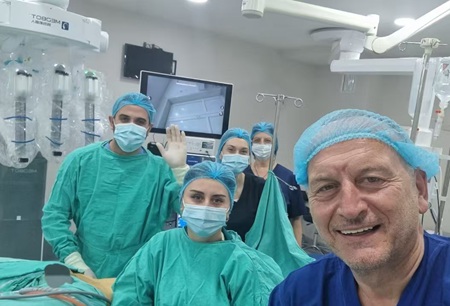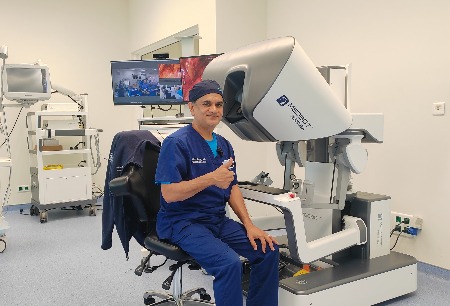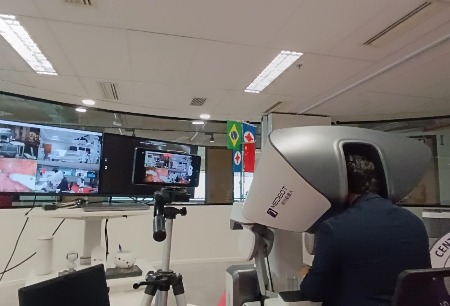Quanzhou, Fujian—After rigorous and sufficient technical justification, animal experiment plus the scientific ethics evaluation, on July 8th, the world’s first four-arm robot assisted radical cystectomy + bilateral pelvic lymphadenectomy + Bricker operation was successfully completed. It was a highly challenging and complex procedure conducted successfully and jointly by the team of Prof. Dan Xia /Prof. Shuo Wang from the First Affiliated Hospital of Zhejiang University School of Medicine (referred to as FAHZU), together with the team of Prof. Zhiyang Huang from the Quanzhou First Affiliated Hospital of Fujian Medical University (referred to as QZFAH), via 5G networking with the assistance of the Toumai® Four-Arm Laparoscopic Surgical Robot (referred to as Toumai® Robot).
The patient was a 69-year-old male, who has repeatedly suffered from frequent micturition, urgent micturition, painful micturition for 1 year. He was sent to QZFAH, with diagnostic TURS pathology revealed: bladder cancer (high-grade papillary urothelial carcinoma). The medical teams from both locations reviewed and analyzed the comprehensive pathological conditions of the patient and came up with rigorous and cautious individualized treatment plan, where Toumai® Robot assisted radical cystectomy + Bricker + bilateral pelvic lymphadenectomy was proposed.
This was a highly complex, highly difficult and lengthy procedure. Therefore, before surgery, Prof. Ping Wang led a surgical team from FAHZU to QZFAH to collaborate with the surgical team of Prof. Zhiyang Huang, to support surgical preparation at local end and ensure the safety of the patient’s surgery. After starting the operation, the basic preparation of the robot surgery was completed by local medical team, including patient anesthesia, reasonable positioning, disinfection, punching and the installation of robot equipment. Once in master-slave control phase, the control of the robotic arm assisting the surgery was taken over by Prof. Shuo Wang, while the local surgical team was providing on-table assistance.
Empowered by the China Telecom 5G networking signal, the Prof. Shuo Wang who was located at the intelligent training center of FAHZU, via Toumai® Robot console, sent commands to the robotic arm of the Toumai® Robot that was located in the operating room of QZFAH. Prof. Shuo Wang operated four robotic arms to gradually sneak through the patient's lower abdominal cavity, clearly freeing tissues such as internal and external iliac arteries and veins, ureters, and obturator nerves on both sides of the pelvic cavity, reaching a skeletal level. Meanwhile, the 4th arm of the robot was utilized to drag and support tissues, providing sufficient operating space and a wide surgical field of view for the surgery, ensuring the smooth progress of the surgery, and maximizing the clearance of bilateral lymphatic tissue. Thereafter, the bladder and prostate were dissected step by step, and with the exposure of the bladder and prostate, as well as the final cutting operation, the dissection and resection of the bladder and prostate were successfully completed. The whole surgery took a total of 4 hours and 18 minutes, and the bleeding volume was only 100ml.
After surgery, Prof. Shuo Wang commented the case that the radical cystectomy + bilateral pelvic lymphadenectomy + Bricker operation was a level 4 surgery that was risky, complex, and challenging. The surgical cleaning involved wider range, where there were abundant blood vessels, nerves, as well as important organs such as the intestine and bladder, which need to be reconstructed. Also, this was a telesurgery that posed rigorous requirements to the 5G signals as well as the performance of the surgical robot – no delay or latency was allowed, device action must be precise with stable operation. This successful minimally invasive surgery assisted by the China-made Toumai® Robot benefited the postoperative recovery and reduced complications for the patient.
-
 2024-11-18Karazanashvili Robotic Center Completed 100 Toumai® Robot-Assisted Surgeries, becoming the Only Robotic Surgery Center in the Caucasus Region
2024-11-18Karazanashvili Robotic Center Completed 100 Toumai® Robot-Assisted Surgeries, becoming the Only Robotic Surgery Center in the Caucasus Region -
 2024-10-26TOUMAI® SURGICAL ROBOT SYSTEM COMPLETES MULTIPLE LANDMARK ROBOTIC TELESURGERY CASES IN SUB-SAHARA AFRICA IN THE REPUBLIC OF ANGOLA
2024-10-26TOUMAI® SURGICAL ROBOT SYSTEM COMPLETES MULTIPLE LANDMARK ROBOTIC TELESURGERY CASES IN SUB-SAHARA AFRICA IN THE REPUBLIC OF ANGOLA -
 2024-10-26Toumai® Achieves South America's First Tele-Surgery Demonstration
2024-10-26Toumai® Achieves South America's First Tele-Surgery Demonstration






 Hu ICP Bei No. 20013662 HGWA Bei No. 31011502015178
Hu ICP Bei No. 20013662 HGWA Bei No. 31011502015178 " are registered trademarks of Shanghai MicroPort Medical (Group) Co., Ltd.” . They have been authorized to be used by Shanghai Microport Medbot (Group) Co., Ltd., and no other party shall use such trademarks without prior written permission thereof.
" are registered trademarks of Shanghai MicroPort Medical (Group) Co., Ltd.” . They have been authorized to be used by Shanghai Microport Medbot (Group) Co., Ltd., and no other party shall use such trademarks without prior written permission thereof.
